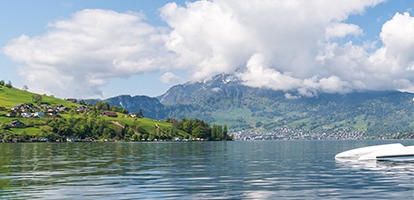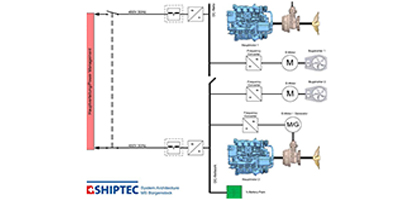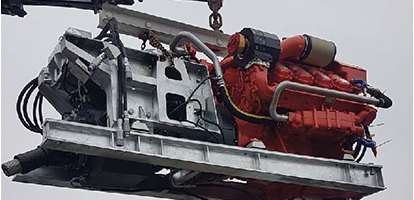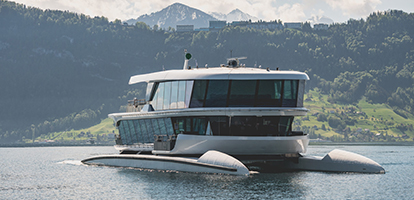




Embedded in a stunning, idyllic mountain setting, Lake Lucerne provides a traditional atmosphere with its fjord-like straights and winding inlets. Right in the middle of this beauty is a daily shipping route bearing tourists between Lucerne and other popular travel destinations, like Weggis and Bürgenstock. While it may sound less than idyllic, it actually boasts an intruiging eco-friendly twist. The MS Bürgenstock, the new motorized vessel belonging to the Lake Lucerne Navigation Company (SGV), sports a quiet and fuel-efficient hybrid drive. Aventics, a specialist of hybrid drive controls in ships headquartered in Laatzen, ensures optimum control between the electric motors and diesel engines. Several years ago, Aventics expanded their solutions by using the WAGO-I/O-SYSTEM 750.
Two years of design and construction came to fruition at the end of May: SGV’s new shuttle, the MS Bürgenstock, embarked on her maiden voyage on the lake, where she navigates the Lucerne-Kehrsiten-Bürgenstock route daily – from early morning to after midnight. Visitors during the initial launch, who expected the typical clatter of diesel engines, were surprised by silence instead. The catamaran, designed as a shuttle by Shiptec AG, was specifically developed to cruise the Lucerne basin in electric mode, supplied by batteries – the diesel engines are required for only half of the route as determined by the captain. According to Rudolf Stadelmann, CEO at Shiptec, “The MS Bürgenstock is a modern, innovative, and ecologically sound ‘bridge’ between Lucerne and Bürgenstock resort.” It is, however, also a fast bridge, as the ship travels at up to 35 kilometers per hour and reaches its destination in a mere 23 minutes.
While designing the drive technology, Shiptec determined the most economically advantageous variant. Using similarly sized ships, comparable travel profiles were developed, and the requirements and consumption by the propulsion system and onboard networks were recorded. Based on this data, they decided on a parallel hybrid power and propulsion system. Martin Einsiedler, head of Ship Design and Engineering at Shiptec, explains that the propulsion systems include two Scania diesel engines with an output of 552 kW each, and two permanently excited synchronous electric motors from Siemens, each with an output of 180 kW. “Basically, we use the diesel engines for travel outside of the harbor areas,” states Einsiedler. “The electric motors function as generators here to supply power for the ship and the system batteries. These batteries, in turn, provide the power for the electric drive and the onboard network in the Lucerne basin. The all-electric system is used for about 50 percent of the entire trip.
Complex System, Reliable Solution
The demands on the drive controls are quite high in order to smoothly perform the complex processes in this hybrid propulsion and energy management system, while guaranteeing fast, reliable transitions between the two power sources. As explained by Marius Mudroch from Aventics, “The complications in hybrid technology lie in the fact that we have two types of drives that differ in their dynamics and behaviors. The captain always has the option of selecting between the drives or cruising with the combined system, depending on the travel profile,” according to Mudroch, who has specialized in the development of hybrid controllers in ship automation during a decade at Aventics; he supervised the Swiss project. The different travel profiles are stored in the controller; in the case of the Bürgenstock, this is a CAN controller from the WAGO-I/O-SYSTEM 750.
“Our own controllers have a limited number of digital and analog inputs and outputs. Therefore, on larger projects with a lot of interfaces – like a hybrid propulsion system – we have used the WAGO 750 Series several years now,” states Mudroch. These controllers are specifically prepared for Aventics devices and are programmed so that the modules can be flexibly combined. “The true practicality of the 750 Series is that we can determine the number of modules ourselves; in the case of our hybrid engine, there are 10 total. The WAGO CANopen Controller (750-837) was selected as the head, which enables CODESYS programming.” Another advantages lies in its fast boot time: when the system is switched on, the controller is operational within a few seconds. “We connect our controller and WAGO’s using the CAN bus, and everything runs.” The functions in the hybrid system are programmed using the WAGO-I/O-PRO software tool in the WAGO controller, which is based on CODESYS 2.3. “Our controller then works in principle like a normal telecontrol device that exchanges information with the WAGO system,” explains Mudroch. All characteristic curve switchover operations are programmed in the 750 Series I/O System, which is where the data is evaluated and forwarded. For example, if the captain selects the electric motor, then the controller prepares the hybrid propulsion system for electric mode. Depending on the demands, the electric motor can then be used as an additional thruster in boost operation, or as a wave generator. In addition, the controller provides analog values, like the diesel engine torque or the lever position. Due to variables stored in the memory, it can be both programmed and also parameterized – parameters represent, for example, when delay times or other functions should be used that must be switched on or off. “There is a good interaction between our controller and the one from WAGO,” emphasizes Mudroch.
Hybrid Propulsion Becomes More Innovative
Two different propulsion sources, more signals – Marius Mudroch points out that the number of potential faults also correspondingly increases. Faults that occur must be treated by the controller so that the ship reacts according to the demands, particularly because it is not immediately obvious to the captain of a hybrid which part of the drive has generated the fault message.” A step chain is generated for each change of mode. After each step, the controller verifies whether it was executed completely. “The regulations from the classification societies determine how the ship should behave in the case of a fault,” explains Mudroch. On a seagoing ship, the last running state during a fault should preferably be maintained so that the captain can decide whether to continue or switch the engine to emergency stop. “Inland waterway ships like the Bürgenstock quickly switch the engine off during a fault, because they can make it to shore relatively quickly,” continues Mudroch.
Mudroch estimates it took around a week to develop the controller, “I have my philosophy and my previous experience to guide how I implement characteristic curve switchover operations. However, the demands placed on hybrid propulsion systems for ships have changed a lot in the past few years.” While the hybrid drives were initially developed as redundant drives in his early projects to forestall failures, the electric drives of today assume a more active part in the systems. The Bürgenstock is actually not the first ship with an electric drive to cruise Lake Lucerne – in 2017, its predecessor model, the MS Diamant, was commissioned by the SGV. Due to its light weight, optimized hull shape, and the hybrid drive, this passenger and event ship saves around 20 percent of the energy required for a comparable, conventional, diesel-driven vessel. “Although the MS Bürgenstock is equipped with similar components to its predecessor, we got a bit more innovative,” states Mudroch. While the Diamant is equipped with an auxiliary diesel for covering high onboard network loads – specifically in the case of large events – this was omitted on the Bürgenstock to reduce noise and exhaust emissions, and to save space. The principle of the drive controller also represented another development, as the Aventics engineer emphasizes, “With the predecessor ship, the engine had to be shifted into neutral in order to switch between propulsion options. This switchover could take a few seconds.” In the Bürgenstock, the diesel switches over to the electric drive while running, once the captain has given the command. “Passengers feel neither the switchover nor the recoupling nor shaking of any kind – everything is compensated for on the drive side.” For Mudroch, they have not reached the end of development – not be a long shot. “As long as I can expand my own controller via programs, inputs, and outputs on WAGO’s controller, then there are still plenty of possibilities.” This also applies to a future digital data transfer between the controller and the cloud, “We don’t yet have remote access to the system, which is probably because the controllers we use are not cloud-capable. However, if the customer specifies this request, then a solution using IoT controllers from WAGO would surely be one option.”
Text: Lars Kuehn and Alberto Alonso Malo, WAGO
Photo: Roger Gruetter, SHIPTEC AG, WAGO